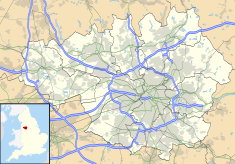The Derby Hall is a Victorian neo-classical building situated on Market Street in the centre of Bury, Greater Manchester, England. It is a Grade II listed building.[1]
| Derby Hall | |
|---|---|
 The Derby Hall, with Athenaeum House on the right | |
| Location | Bury |
| Coordinates | 53°35′34″N 2°17′49″W / 53.5929°N 2.297°W |
| Built | 1850 |
| Architect | Sydney Smirke |
| Architectural style(s) | Neo-classical |
Listed Building – Grade II | |
| Designated | 3 February 1971 |
| Reference no. | 1067239 |
History
editThe Derby Hall was built in the late 1840s at the instigation of Edward Smith-Stanley, 13th Earl of Derby.[2] It was designed by Sydney Smirke, an architect best known today for his work on the circular reading room at the British Museum.[3] The building has a central Venetian window and a pedimented portico with four attached columns.[4]
It was originally the central part of a larger development that included the Derby Hotel on the left, and the Athenaeum on the right (both also designed by Smirke). These other two buildings were demolished in 1965[2] and 1971, respectively.[5] Construction of the building began at Christmas 1848 and was completed in October 1850.[6] The hall was opened on 6 November 1850 with a concert which was attended by 600 people.[7]
The building was originally known as the Public Rooms, although it quickly became known as the Town Hall. At its opening, it contained a magistrate's court, a police station, the Earl of Derby's estate offices and a large assembly room.[2] Stanley hoped the building would become the meeting place for Bury's council; however, owing to a disagreement between the earl and the local authority, it was not initially used for that purpose.[2] After the First World War the council acquired the building from the Stanley family and used it as a council building.[8] The council moved to the new Town Hall on Knowsley Street in 1954[9] and, since 1979, the building has been operated by a registered charity called Bury Metropolitan Arts Association, which uses it as a theatre and concert venue known as The Met.[10][11]
One notable concert held in the building was by rock band Joy Division on 8 April 1980, which descended into a riot after some of the audience started throwing bottles at the stage. This was because Alan Hempstall of Crispy Ambulance and Simon Topping of A Certain Ratio filled in on vocals, since Joy Division's own lead singer Ian Curtis was recovering from an attempted suicide attempt the previous day.[12]
See also
editReferences
edit- ^ Historic England. "Derby Hall, Bury (1067239)". National Heritage List for England. Retrieved 8 July 2020.
- ^ a b c d "The 120-year-old unsolved mystery of Bury hotel double suicide". Bury Times. 9 February 2020. Retrieved 8 July 2020.
- ^ "Sydney Smirke". British Museum. Retrieved 20 July 2020.
- ^ Pevsner, Nikolaus (1969). The Buildings of England: South Lancashire (1st ed.). London: Penguin. p. 99. ISBN 0-14-0710-36-1.
- ^ "Origins and history of the Athenaeum". Retrieved 8 July 2020.
- ^ The Manchester Courier, and Lancashire General Advertiser, Saturday 5 October 1850, p. 5
- ^ "Bury, Lancashire". The Musical Times. 4 (79): 106. 1 December 1850. JSTOR 3370331.
A concert was given on the 6th of November, on the occasion of the opening of the new town hall, built from a design by Sidney Smirke, of London : it will accommodate 500 persons, but the audience, on this occasion, numbered 600. The formation of a Philharmonic Society in Bury, has been decided upon.
- ^ "Bury' Met set to re-open after £4.6 million refurbishment". About Manchester. 6 December 2016. Retrieved 8 July 2020.
- ^ Frain, Sean (2013). The Bury Book of Days. The History Press. ISBN 978-0752485829.
- ^ "Bury Metropolitan Arts Association". Open Charities. Retrieved 11 September 2011.
- ^ "Bury Metropolitan Arts Association". Charity Commission. Retrieved 11 September 2011.
- ^ Curtis, Deborah (1995). Touching from a Distance: Ian Curtis and Joy Division. London: Faber. p. 117. ISBN 0-5711-7445-0.
